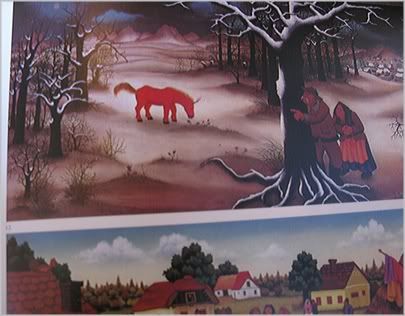Eventually I suppose I'll settle down enough to throw away all the files that aren't absolutely essential to the continued viability of my thesis project, which I finished (for the moment) in April of 2010. For now, my first full-length, full-color picture book attempt is so heavily backed up that I could recreate most stages of most pages. And that's what I'm doing in this post: describing the laborious, sometimes blind and stumbling thoughts that accompanied me through eight months and into a page I actually like.
Here, a thumbnail and a first attempt at a book dummy, where the thumbnail is expanded. On this page Warden is noticing that the color he dislikes is showing up not only in common spaces of the house, but also in his personal spaces.

These next versions come from the next two book dummies. I constantly updated pages, usually for clarification of content. Technical rendering can be finessed at a later time, once the story is solid and flows like it should. By this point I'd realized that every instance described didn't have to be shown, and so I'd done away with two-part vignette pages.

Now things became more highly rendered. It was good to test how I wanted pages to eventually look, but I still ended up drastically re-drawing several more times.

I began to want more solidity to this page. The page hadn't worked to my liking yet, and I was determined to have the scene facing straight-on. My instincts usually lead me to overburden a page, rip it up, make the same mistake again, and then wise up and strip it back down to its most important elements. This is when, for me, things take real shape. I haven't found a shortcut to this completely arduous approach.

Last comes shifting, tightening and coloring. The shifting comes courtesy of Photoshop, as do the light gradients of color. Other pieces of color were inked separately and then scanned in. The texture was scanned and manipulated separately, as well.

And, so far, that's how this process looks for me. My goal is to to cut out half the steps in future attempts by being better able to see the whole and nudge out hiccups in tone.




































